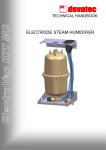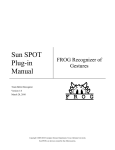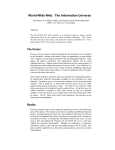Download an Application to Water Quality Monitoring in Malawi
Transcript
On the design of a Water Quality Wireless Sensor Network (WQWSN): an Application to Water Quality Monitoring in Malawi Marco Zennaro, Athanasios Floros, Gokhan Dogan, Tao Sun, Zhichao Cao, Chen Huang, Manzoor Bahader, Herve’ Ntareme The Royal Institute of Technology Telecommunication Systems Laboratory Stockholm, Sweden Email: [email protected] Abstract—More than one billion people lack access to safe drinking water in the world. Providing a way to measure automatically water quality will help tackle this problem. This paper presents the design of a water quality measuring system and proposes a prototype implementation of a water quality wireless sensor network (WQWSN) as a solution to this challenging problem. When applied to developing countries, the design and implementation of such a system must take into consideration the difficult environment in which it will operate. An application to water quality measurement in Malawi reveals the relevance of using our novel solution to mitigate two challenging issues: energy consumption of the system and the inter-networking problem. I. I NTRODUCTION According to the United Nations in 2005, an estimated 1.1 billion people worldwide lack clean drinking water and 2.6 billion lack access to basic sanitation [1]. Hence, 2005-2015 was designated the International Decade for Action: ”Water for Life”. Clearly, the international community has recognized that water distribution must be carefully monitored and controlled in terms of water quality and quantity. Water quality can be thought of as a measure of the suitability of water for a particular use based on selected physical, chemical, and biological characteristics [2]. To determine water quality, scientists first measure and analyze characteristics of the water such as temperature, dissolved mineral content, and number of bacteria. Selected characteristics are then compared to numeric standards and guidelines to decide if the water is suitable for a particular use. Standards and guidelines are established to protect water for designated uses such as drinking, recreation or agricultural irrigation. Standards for drinking-water quality ensure that public drinkingwater supplies are as safe as possible. Some aspects of water quality can be determined right in the stream or at the well. The basic parameters to be measured include acidity (pH), dissolved oxygen, and turbidity (a measure of the clarity of the water) [3]. Analyses of individual chemicals generally Antoine Bagula Department of Computer Science Third Floor, 18 University Avenue Rhodes Gift, 7707 University of Cape Town Western Cape, South Africa Email: [email protected] are done at a laboratory. In many Developing Countries, monitoring procedures are currently entirely manual, based on sampling and subsequent analyses in water laboratories. This often causes considerable delays in the monitoring process. The quality of the monitoring process would benefit from at least some basic parameters being monitored in real time, in order to get early warnings that can trigger appropriate treatment. Emerging technologies can be used to provide relatively inexpensive, coordinated, intelligent networks allowing a wellcoordinated and continuous monitoring of surface waters. Environmental sensor networks are wireless sensor networks that may provide a key element for better understanding and managing the water cycle. A typical wireless sensor network is composed of sensor nodes often referred to as motes which sense their environment and a wireless sensor base station that collects the information sensed by the motes for local and/or remote processing. Such networks have been proposed and/or are being developed for a variety of environmental applications [4], but their deployment to measure water quality is still in its infancy. This paper proposes an integrated sensor network for water quality monitoring and describes its application to water quality monitoring in Malawi. In the newly proposed network referred to as Water Quality Wireless Sensor Network (WQWSN), sensors become an integrated component of their aqueous environment throughout data collection, and data are communicated between nodes and back to researchers remotely using wireless connections. In addition to describing the development of the system, we describe ongoing and future research related to the challenging environment in which the network is going to be installed. When designing a system to be deployed in a challenging environment like the African one, one has to carefully take into consideration local conditions. The two main contributions of this paper are: 2 Energy consumption. Although energy consumption is a well-adressed issue for WSN nodes [5], water quality measurement adds another dimension to this issue since one has to take into account the contribution of the energy consummed by the water quality sensors in the overall energy consumption of the water monitoring system. As low-power sensors for water quality are not yet commercially availiable [6], we propose an energy consumption minization strategy where a wake-up mechnaism that triggers sleeping/wake-up modes is used to reduce energy consumption. Furthermore, while most current development solutions assume that logging devices will encounter ideal scenarios in terms of power and connectivity, this is not true in many Developing Countries where power is not stable. We propose a low-power gateway node that can save the measurements and make them available in a web application. Inter-networking The gateway is the component that enables the inter-networking between the 802.15.4 and ZigBee protocols used in a WSN environment with different other protocols such as WiFI, WiMAX, MPLS, and others to allow the dissemination of the sensed information for further processing and/or decision making. A gateway that is intended to be deployed in challenging environments such as those of the African continent should be appropriately designed to meet stringent power, communication and reliability requiments. While PCs and laptops are currently being used as part of a gateway environment, we propose a flexible gateway solution that builds upon an ALIX2 embedded Linux board from PC engines [7]. Our gateway is compact, lightweight, has highperformance and lower power and can be used as a wireless Access Point, client or a mesh node in an OLSR based wireless network. The remainder of this paper is as follows. Section 2 presents the proposed WQWSN solution while the experimental results on power consumption and wireless sensor lifetime are presented by section 3. Section 4 reports on an application to water quality monitoring in Malawi. Our conclusions and future work are presented in section 5. II. T HE WQWSN D ESIGN For the initial deployment of the system, we are interested in studying fluctuations in pH, dissolved oxygen, temperature, and dissolved oxygen. Sensor data need to be gathered at intervals of one hour, and data collection has to be automated and the data easily retrievable at the end of the observation period. The rest of this section describes the system architecture used to meet these requirements and the different components of the water quality monitoring system. The ultimate purpose of the WQWSN is to automate the monitoring of drinking water quality. The general work flow of the system to be designed consists of (1) taking water quality samples at a pre-defined time of the day, (2) sending and storing sampled data in the gateway station, (3) going to sleep afterwards and (4) waking up and repeating the previous steps. These four steps may be mapped into a three-layer system architecture depicted by Figure 1 which includes (1) a wireless Fig. 1. WQWSN system architecture Fig. 2. The gateway sensor gateway layer, (2) a wireless sensor node layer and (3) a water sensor board layer. Following is a description of the single layers. A. The wireless sensor gateway layer The gateway is one of the most important components upon which the efficiency of the sensing activity of a WSN depends. It collects all the information received from the motes in a database and makes this information available usually via a wireless network. A gateway must have enough computing power to be able to run a database, perform local calculation and communicate with an existing network, but should be low power enough to run autonomously in the field. If a gateway is to be used for WSNs in Developing Countries, it is clear that the scenario requires a device designed around the following constraints: low-power consumption (to run using solar panels or using batteries), high storage capabilities (to be able to store data for a long period of time, in case of remote deployments), flexible connectivity (to be able to connect to the network via wired or wireless connection using different topologies), low-cost (to be suitable for deployments in Developing Countries) and web-based design (to allow users to visualize the data from the WSN without installing specific software). To develop our gateway we selecetd an ALIX 2 embedded Linux board [7] built by PC engines as depicted by Figure 2. It is based on the 500 MHz AMD Geode processor with 256MB of DRAM, has two USB ports, one Compact Flash socket, two miniPCI slots and two Ethernet ports. It is powerful enough to run a database and a web server. We decided to use a 1G CF memory card, capable enough to store the OS and sampled data. It is compact, lightweight, has high-performance and low power consumption. It can be used as a wireless Access Point, Client or mesh node. Using one wireless card, it consumes 4.4 W. This value is low enough to be able to use a 20W solar panel and a 14 AH battery to make the gateway autonomous. With a 1G Compact Flash card, it can store months of measurements. 3 B. The wireless sensor node layer The wireless sensor nodes were assembled from comercially available SunSPOT motes [8] with an additional board. What distinguishes the Sun SPOT from comparable devices is that it runs a Java Micro Edition Virtual Machine directly on the processor without an operating system. The Sun SPOT system uses JavaTM technology to up-level programming. Each device comes with a 180 MHz 32-bit ARM920T core, 512K RAM, 4M non-volatile Flash memory, 802.15.4 radio and a USB interface. Six analog-to-digital converter inputs and five general purpose I/O pins can be used to add custom sensors and devices. The internal battery is a 3.7V 720maH rechargeable lithium-ion prismatic cell. The battery has internal protection circuit to guard against over discharge, under voltage and overcharge conditions. The Sun SPOT drops into a power saving mode (”shallow sleep”) to reduce power consumption and extend battery life whenever all threads become idle. Considerable power can be saved during shallow sleep even though it is still necessary to power much of the Sun SPOT hardware. Hence, the Sun SPOT can resume from shallow sleep without any latency and as soon as any thread becomes ready to run. The shallow sleep power consumption mode is about 28ma with the radio off. A SunSPOT kit comes with two free-range Sun SPOT units and one base station unit. The base station unit is thinner, does not have a battery board, communicates wirelessly with the free-range units and streams the data via a USB connection. The SunSPOTs were selected for their ease of use and available interfaces. Connected to the SunSPOT is an additional board called eSerial. It is a stackable add-on board for the SunSPOT motes providing a single RS232 connection. The board requires an extension flat ribbon cable to the appropriate DB9 or DB25 connector. It contains the identification serial Flash memory, RS232 level shift circuit, and activity LEDs. An eSerial is shown in Figure xxx. C. The water sensor board layer The 90-FLT series E sensor [9] purchased by TPS in Australia made it possible to measure pH, conductivity, TDS, dissolved oxygen, turbidity and temperature. All data can be saved and downloaded directly to a computer via the standard RS232 port. Many instrument functions can also be controlled from the computer. The 90-FLT water quality sensor is composed of a main unit and some sensor probes: turbidity, pH and dissolved oxygen. The probes are the parts to be immersed in water, while the main unit must be outside. This device is big in size (230 x 140 x 100 mm) and the cost is 3400$ including sensors and cables. The 90-FLT device needs to be calibrated before making any measurement. In a standard calibration the sensors are put into a sample solution of known standard values for PH, turbidity, conductivity and TDS and then the meter is calibrated. When all the calibrations have been successfully performed then the sensors are ready to be put into any unknown solution to make Fig. 3. eSerial board Fig. 4. 90-FLT sensor the measurement. It would be a good practice to calibrate the device on weekly bases to get correct results. III. T HE WQWSN I MPLEMENTATION The main actor in the system is the wireless sensor node. During a measurement, it 1) wakes up, 2) fetches the latest data from the 90-FLT and 3) passes the data to the SunSPOT base station. Fetching data is the process of communicating with the 90-FLT sensor. It includes waking up the sensor by sending a specific string via the serial connection, reading data from the sensor, and turning the sensor off by sensing another string. Passing data to the SunSPOT base station, on the other hand, includes assembling data in a more readable format and sending it via radio to the host station. The SunSPOT base station is connected via USB to the gateway as depicted by Figure 2. Data coming from the free-range SunSPOTs reach the SunSPOT base station via a 805.14 wireless link. The java code running on the base station connects to the MySQL database that runs on the gateway and stores the received data in the database. The SunSPOT base station is also responsible for 1) sending the configuration files to the free-range SunSPOTs (containing the measurement times) and 2) synchronizing the clocks. With the challenging African environment in mind, we implemented the software to tackle the two main problems encountered: energy consumption and inter-networking. Following are the mechanisms we developed. A. Wake-up mechanism In order to prolong the system lifetime, we decided to turn off the deviced we didn’t use. We used the external eSerial board to switch off the 90-FLT sensor when not reading data. It was quite easy to turn on and off the 90-FLT. Sending a special string via the serial port was enough to power it on and off. Furthermore, we powered down the eSerial itself when not communicating with the 90-FLT. In this way, we powered just the SunSPOT’s motherboard when in idle mode. B. Inter-networking Based on Linux, the gateway we developed is flexible enough to work in different scenarios and to provide a way to 4 IV. P ERFORMANCE EVALUATION Using four sensor motes and one gateway, we conducted different experiments to evaluate the performance of the newly proposed system and the impact of the wireless sensor network on water quality monitoring. We considered different performnace parameters. These include: (1) the power consumption and (2) the lifetime of the sensor network in different sensing scenarios. While the power consumption is a parameter that measures the power utility of a wireless sensor device, a wireless sensor network lifetime is expressed by the battery levels of its components. A lower power consuming wireless sensor network is preferable to a highly power consuming wireless sensor network. A wireless sensor network with long life batteries would be preferred to a short lived batteries since it provides a higher lifetime for the system monitored. A. Determining the lifetime of the WQWSN system. We conducted a first set of experiments to determine the lifetime of the WQWSN by comparing the lifetime of the SUN SPOT and 90-FLT device to evaluate their impact on the lifetime of the system: the lifetime of the system will obviously depend on the lifetime of the shortest lived of the two devices. Figure 5 and 6 report on the relationship between the battery lifetime of the 90-FLT device and the free-range Sun SPOT in number of days and number of measurements per day. These Figures show that the 90-FTL device has much longer life than the free-range Sun SPOT. So the system life depends on the life of free-range Sun SPOT. The usual sample frequency is 24 times per day. In this situation, the Sun SPOT can work for 14 days. B. Determining the power consumption of different water probes. We conducted another experiment to determine the energy consumed by the system when using different probes sepa- 7000 90−FLT battery level Battery level in mV 6000 5000 4000 3000 2000 1000 0 0 5 10 15 20 25 30 Measurements per day Fig. 5. 90FLT lifetime 28 Free−range SunSPOT life 26 24 Battery level in mV interconnect different networks. For example 802.11 wireless. It could work as a client connected to an access point which is then connected to the Internet. Users could use a web browser to access the data via a web application. Given possible long distances involved in the deployment, we think that the best solution is to implement a mesh protocol such as OLSR [10] in the gateway. In this way one deploys more gateways, each connected to different SunSPOT networks, and the gateways automatically form a network. One of the gateways is connected to the internet, and traffic is automatically routed to it by OLSR. Each gateway runs an instance of MySQL, and the gateway connected to the internet hosts a database with data coming from all the databases. This is done via MySQL replication mechanism [11]. Replication is asynchronous by default - the master gateway does not need to be connected permanently to receive updates, which means that updates can occur over long-distance connections and even temporary solutions. Depending on the configuration, once can replicate all databases, selected databases, or even selected tables within a database. We tested this solution and it works perfectly given the Open Source software used. 22 20 18 16 14 12 0 5 10 15 20 25 30 Measurements per day Fig. 6. SunSPOT lifetime TABLE I P OWER CONSUMPTION FOR OXY: OXYGEN , C ON : C ONDUCTIVITY, T UR : T URBIDITY None probe All probes Oxy+Con+Tur Oxy+Con+Tur+pH Oxy+Con+Tur+Redox Con+Tur Tur Oxy Con Oxy+Con Oxy+Tur Con+Tur Voltage(V) Current(A) Power(W) 14.3 14.03 13.97 13.97 13.97 14.05 14 14.24 14.25 14.33 14.06 13.99 0, 03 − 0, 04 0, 04 − 0, 05 0, 04 − 0, 05 0, 04 − 0, 05 0, 04 − 0, 05 0, 04 − 0, 05 0, 04 − 0, 05 0, 03 − 0, 04 0, 03 − 0, 04 0, 03 − 0, 04 0, 04 − 0, 05 0, 04 − 0, 05 0, 4 − 0, 5 0, 5 − 0, 7 0, 6 − 0, 7 0, 6 − 0, 7 0, 6 − 0, 7 0, 5 − 0, 7 0, 5 − 0, 7 0, 4 − 0, 5 0, 4 − 0, 5 0, 4 − 0, 5 0, 5 − 0, 7 0, 5 − 0, 7 rately or together. The results presented by Table I reveal a uniform pattern where when (1) using each of the probes alone consumes less power than when two or more probes are used (2) some of the probes such as Oxy and Con require higher voltage (14.24, 14.25 V) than others such as Tur (14 V) but using higher current (0, 03 − 0, 04 A) and consuming more power(0, 5 − 0, 7 W compared to 0, 4 − 0, 5 W) and (3) the combinations of two or more probes lead to different performance patterns in terms of voltage, current and power. C. Extending the lifetime of the WQWSN using a wake-up mechanism. The wake-up mechanism is designed for saving energy. We conducted a second set of experiments with and without wakeup mechanism to evaluate the energy savings resulting from the wake-up mechanism in a system setting where the level converter is powered by the free-range Sun SPOT while the 5 D. Extending the lifetime of the WQWSN using power control Besides the wake-up mechanism, power control is another mechanism that provides the potential to extend the lifetime of a wireless sensor network. This may be done by either reducing the power transmission to reach less neigbour sensors or increasing the power transmission when needed to extend a sensor’s reach. We conducted another set of experiments using a power adjustment application under different dis- 8.5 90−FLT with wake−up mechanism 90−FLT without wake−up mechanism 8 Volts 7.5 7 6.5 6 5.5 0 50 100 150 200 250 Samples Fig. 7. Impact of wakeup mechanism on SunSPOT 700 Free−range SunSPOT with wake−up mechanism Free−range SunSPOT without wake−up mechanism 600 500 Battery Capacity basestation Sun SPOTs power is supplied by the computer so that only the power consumption of the 90-FLT meter and the free-range Sun SPOT are taken into account. The experiments were run by having the system firstly runing without the wakeup mechanism for 4 days by taking 60 measurements per day and thereafter having the same system runing with wake-up mechanism for another 4 days also by taking 60 measurements per day. For the experiment using wake-up mechanism, the free-range Sun SPOT and 90-FLT woke up for 50 seconds in each measurement in order to transfer the latest measurements via serial connection. In each of the two experiments, the base station was used to record the 90-FLT battery level and the free-range Sun SPOT battery capacity for each measurement. The results are depicted by Figures 7 and 8 which show the battery life of the free-range Sun SPOT and 90-FLT meter with and without wake-up mechanism in both of the experiments. From this figure, it is obvious that the wake-up mechanism results in a lot of energy savings. The free-range Sun SPOT can operate in two energy modes referred to as wake-up and deep-sleep phases. Assume that WPC is the power consumption per second of the freerange Sun SPOT in wake-up phase and SPC is the power consumption persecond of the free-range Sun SPOT in deepsleep phase. According to the experimental results, WPC is 0.021627 mA/s, and SPC is 0.000308 mA/s. Assuming that N is the number of measurements per day, the power consumption per day is W P C ∗ 50 ∗ N + SP C ∗ (86400 − 50 ∗ N ) = 1.06593N +26.6112 mA. As the fully charged battery capacity of the Sun SPOT is 720mAh, the free-range Sun SPOT can 720 work for 1.06593N +26.6112 days. As the curve of 90-FLT battery level is not strictly linear, the battery life of 90-FLT in the system cannot be estimated directly from the data as it is the case for the Sun SPOT. According to the 90-FLT manufacturer’s information [12], when the battery is fully charged, the device provides the capability to read data every half hour, continuously for over 40 days. The device is powered off between readings and only powered on for three minutes whenever a reading is due. So the device can keep working for 40 ∗ 24 ∗ 2 ∗ 180 = 345600 seconds which is around 4 days. The experimental results depicted by Figure 8 show that after about 4 days, the battery level decreases to a warning level of 5.6 volts. This reveals that the data from the manufacturer’s information is reliable. Assuming that N is the number of measurements per day, the device wakes up for 50 seconds each time, and the 90-FLT meter consumes zero energy when it is off. The device can last for 345600 50N days. 400 300 200 100 0 0 Fig. 8. 50 100 Samples 150 200 250 Impact of wakeup mechanism on 90-FLT TABLE II D ISTANCE VS P OWER C ONSUMPTION : MAXIMUM POWER Distance (m) 50000 packets Broadcast (mA) Unicast (mA) 100000 packets Broadcast (mA) Unicast (mA) 0 20 40 60 12,5764 17,7225 12,4254 17,8313 12,3494 17,8194 12,5623 17,7995 25,0977 35,6845 24,8324 35,5227 24,9410 35,7539 24,8964 35,7750 tances to discover the power consumption of the Sun SPOT using different output powers. Using a certain amount of packets transmitted between two Sun SPOTs, we tested both unicast and broadcast transmissions. Note that since unicast transmission has an inherent ACK/retry mechanism, it could consume more power. We conducted the experiment by having the received packet carrying the battery information of the transmitter in order to make the receiver able to calculate the power consumption during transmission. We conducted a first experiment to discover the effect of distance on power consumption. Theoretically, under same output power, the distance has no effect on power consumption. To prove this, the same amount of packets were transmitted with maximum output power under different distances (0m, 20m, 40m, 60m). We decided to use the maximum power in order to reduce the chance of packet loss. The results presented in Table II below reveals that the Sun SPOT consume almost the same power at different distances. . We condcuted another experiment to compare the power consumption for different output power. Based on the first experiment, we conducted only the experiments under 0 m distance. The results presented in Table III below show that by reducing the transmission power, the power consumption is reduced but not significantly. This is due to the Sun SPOT which consumes lots of power in normal operation. These 6 TABLE III P OWER C ONSUMPTION VS . T RANSMISSION P OWER 50000 packets Transmission power -32 +31 100000 packets Transmission power -32 +31 Broadcast (mA) Unicast (mA) 12,3897 12,5764 17,4098 17,7225 Broadcast (mA) Unicast (mA) 24,6764mA 25,0977 mA 35,0060 35,6845 include the power of running CPU, memory control, etc. But broadcast consumes much less power than unicast since broadcast does not need MAC layer acknowledgement. As a result, the power adjustment using power control did not result in any benefits for our system; the power used by the adjustment was much greater than the power saved. The main power saving technology in this system would result from the use of the shallow and deep sleep modes whenever possible. These modes can thus be used in a real life environment to increase the lifetime of the WQWSN network. V. A PPLICATION TO WATER Q UALITY M ONITORING IN M ALAWI In Malawi, out of a population of 11.8 million, only 62% (95% urban and 58% rural) have access to safe drinking water and 64% (90% urban and 60% rural) have adequate improved sanitation [13] (Malawi Demographic Health Survey, 2000). Although low priority has been given to water and sanitation programs, water quality has been a major cause of mortality especially for children under five year old. The first implementation of our system will be at the Blantyre Water Board, responsible for delivery of water supply and services in the city of Blantyre. The Blantyre Water Board has two water intake stations. Mudi dam is the smaller of the two intake stations and it provides approximately 10% of the water used in Blantyre. The other station is located on the Shire River in Chikwawa district and accounts for 90% of the total water used in the city. The catchment area of Mudi Dam also houses the main laboratories that monitor physical, chemical and bacteriological parameters to control water quality. The water that flows into Mudi Dam (about 1 km2 xxx ) comes from two small rivers: Namimba Stream and Mudi Stream. When the Dam fills up at the end of the rainy season (January- March) the overflow is drained into Mudi river which ultimately flows into the Shire River. The water pumped from the Dam is first treated with a coagulant then passed through a set of pools for sedimentation, sand filtration and finally chlorination. After a site survey at the Chichiri premises, we decided we would place three wireless sensors to monitor water quality: one in the catchment area and two following the treatment process. The distances between the pools is of about 100 meters, while the catchment area is some 300 away. The results of the analysis will be used both at the Water Board and at the Malawi Polytechnic, so a web server publishing the results is a must. From the connectivity point of view, the Water Board has an ADSL connection and we are going to use that to connect to the Internet. VI. C ONCLUSIONS AND FUTURE WORK This paper proposes the design of a water quality monitoring system and, building upon the SunSPOT technology, a prototype implementation of a water quality wireless sensor network (WQWSN) as a solution to the water quality monitoring problem. Using a three-layer architecture, we discuss the main features of the newly implemented system and propose its application to water quality measurement in Malawi. The experimental results reveal the relevance of using our novel solution to mitigate two challenging issues: energy consumption of the system and the inter-networking problem. Besides Malawi, the deployment of the WQWSN to measure water quality in the rural areas of South Africa, Mozambique , Tanzania and the DRC has been planned as an extension to this work. Its expansion into a WaterQualitySensorWeb (WQSW) is also a further step to the extensions of our proposed WQWSN prototype. ACKNOWLEDGMENTS WQWSN is a project supported by SPIDER, the Swedish Program for Information and Communication Technology in Developing Regions. R EFERENCES [1] United Nations, ”Water, a shared responsibility”, The 2nd UN World Water Development Report, March 2006. [2] J. Bartram and R. Ballance, ”Water Quality Monitoring - A Practical Guide to the Design and Implementation of Freshwater Quality Studies and Monitoring Programmes”, Edited by Published on behalf of United Nations Environment Programme and the World Health Organization, ISBN 0 419 22320 7 (Hbk) 0 419 21730 4 (Pbk), 1996. [3] World Health Organization, ”Guidelines for Drinking-water Quality”, World Health Organization, 3rd Edition, Volume 1,ISBN 92 4 154696 4, Available: http://www.who.int/mediacentre/news/releases/2004/pr67/en/), 2006. [4] J. Porter et all, ”Wireless Sensor Networks for Ecology”, Bioscience 55:77, Pages 561-572, July 2005. [5] Zhen Fang et all, ”Ultra-Low Power WSN Node with Integrated THP Sensor”,1st IEEE International Conference onNano/Micro Engineered and Molecular Systems Pages813 - 816, January 2006. [6] J. Goldman et all,”Distrbuted Sensing Systems for Water Quality Assesment and Management”, Center for Embedded Network Sensing Papers, Paper 107. http://repositories.cdlib.org/cens/wps/107, February 1, 2007 [7] Alix2 board. Available: http://www.pcengines.ch/alix2c2.htm [8] SunSPOT world. Available: http://www.sunspotworld.com [9] TPS Field Lab Analyzers for PH, mV, Conductivity, TDS, Dissolved Oxygen, Turbidity and ture. Available: http://www.tps.com.au/products/combination/90-fl.htm [10] Optimized Link State Routing. Available: http://www.olsr.org [11] MySQL Replication. Available: dev.mysql.com/doc/refman/5.0/en/replication.html [12] 90-FLT User Manual. Available: http://www.tps.com.au/handbooks/90FLTv9 01.pdf [13] Malawi Demographic and Health Survey 2004. Available: http://www.measuredhs.com/pubs/pdf/FR175/FR-175-MW04.pdf



























